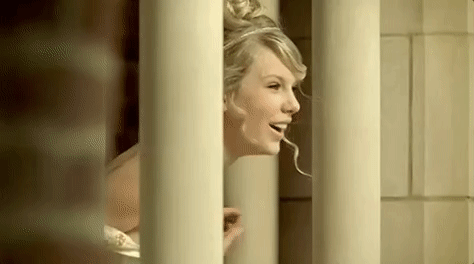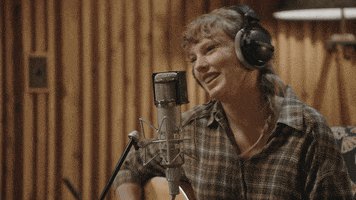You’re On Your Own Kid: Taylor Swift’s Career Narrative
This week we explored Taylor's storytelling skills in "Is It Over Now?" "You're On Your Own, Kid," and "no body, no crime"
But I ain't letting up until the day I die. Taylor Swift is truly a storytelling queen, but how does she do it? In this week’s episode, we took a look at how Taylor plays with narrative structure to create compelling stories in her lyrics. From fairy tale distortion in “Is It Over Now?”, a murder mystery arc in “no body, no crime,” to the heart-tugging Bildungsroman of “You’re On Your Own, Kid,” this episode explores the how behind the heartbreaks, twists, and self-discoveries.
🎧 Listen above and ⬇️ scroll below to read Jenn’s extra credit exploring the narrative structure of Taylor’s real-life career.
✨ We want to hear from you! ✨
Whether you listen weekly, read occasionally, or just joined us—this quick survey helps us understand who’s here and how to make the podcast + newsletter even better. It takes 5 minutes, and we’d be so grateful for your input.
📜 This Week’s Extra Credit by Jenn
The bildungsroman, or coming-of-age narrative, typically follows protagonists through their psychological and moral growth from youth to adulthood. These stories chart the ups and downs in our hero’s journey. As I mentioned in this week’s episode, discussing the bildungsroman structure made me realize that Taylor’s career trajectory could definitely be mapped onto this classic narrative structure, offering us a real-world bildungsroman playing out across albums, eras, and public perception.
The Structure of a Bildungsroman
Before diving into Taylor’s career specifics, let's clarify the typical structure of a bildungsroman using Jane Eyre by Charlotte Bronte as an example:
The Call to Adventure: Jane leaves the Reed family home where she was mistreated, to attend Lowood Institution.
Development and Education: At Lowood, Jane acquires education and becomes a teacher herself despite her humble origins.
Social Integration and Success: Jane finds employment as governess at Thornfield Hall and ultimately rises socially through her engagement to Rochester, a connection that transcends class boundaries.
Conflict and Crisis: Jane's wedding is dramatically halted by the revelation of Rochester's mad wife Bertha, forcing her to flee Thornfield.
Reflection and Growth: Wandering homeless, Jane is taken in by the Rivers family at Marsh End, and she discovers her true identity.
Reintegration and Mastery: Jane returns to Rochester on her own terms, now wealthy, self-possessed, and guided by her moral principles. She finds him humbled and blinded after Thornfield's destruction, and they reunite as equals in a marriage based on mutual respect and understanding.
A key part of the bildungsroman journey is that if Jane and Rochester had married at stage three, that would have been wildly inappropriate by the standards of the day. These stories were not only entertaining, but also served as a didactic tool that reminded society what is and is not appropriate. Jane’s happy ending occurs when she and Rochester are more equal in social stature.
Keep that in mind as we look at this journey for Taylor’s career. Let's trace this development chronologically.
Early Years: The Call to Adventure
In the classic bildungsroman, our protagonist must first leave home either literally or emotionally. For Taylor, this began with her family's relocation from Pennsylvania to Nashville in her early teen years, specifically to pursue her music career. This geographic disruption mirrors the bildungsroman's initial catalyst: the separation from the familiar.
Her self-titled debut album represents her leaning into this adventure and starting something special. Like many bildungsroman protagonists at the start of their journey, Taylor possessed raw talent but was looking ahead to a path that would provide her with the chance to develop that talent even more.
Fearless to Red: Development and Education
The bildungsroman typically features a period of education, where the protagonist acquires skills and begins forming their identity. Taylor’s second album, Fearless, marks this developmental stage, as she began crafting more complex narratives while maintaining her country roots (hello “Love Story”).
By Speak Now, Taylor was ready to take complete creative control by writing the entire album solo. Red further expanded her musical education as she began experimenting with pop elements while maintaining country sensibilities.
Throughout this period, Taylor was navigating the music industry, learning its mechanisms, and developing her craft under the public eye. This mirrors how a bildungsroman hero undergoes trials and education before their first major triumph.
1989: Social Integration and Success
The release of 1989 marks Taylor’s arrival at the "social integration" phase. She had successfully transitioned to pop music, earning critical acclaim and commercial success beyond her previous achievements.
Also worth noting at this phase is the role that the media and other external factors play in the story of Taylor. It was clear during the 1989 era that, while Taylor’s success was praised in the media, it seemed like the narrative was that she had gotten successful enough. She was no longer the underdog, so the narrative had to change (according to the media, definitely not according to me!).
The Kanye Incident and Reputation: Conflict and Crisis
No bildungsroman is complete without a fall from grace. For Taylor, this pivotal moment came with the 2016 public backlash following her feud with Kanye. The public narrative shifted dramatically, with #TaylorSwiftIsOverParty trending worldwide and Taylor fully retreating from public view.
This period represents the classic crisis point in the bildungsroman structure, the moment when the protagonist's carefully constructed world collapses, forcing deep introspection and revealing the limitations of their previous identity and understanding.
Reputation emerged from this darkness as Taylor’s response to public vilification. Just as bildungsroman protagonists must face their darkest moments, Taylor confronted her public persona's destruction and began rebuilding from the ruins.
Lover to folklore/evermore: Reflection and Growth
Following a crisis, the bildungsroman protagonist typically enters a period of reflection, where they reassess their values and develop deeper understanding. With Lover, Taylor began this reflective process and embraced her chance to start over with a new label where she was able to own her music.
The unexpected arrivals of folklore and evermore during the pandemic represented even more profound artistic growth with her pivot to literary storytelling and emotional depth that reflected a new stage of life and the maturity that comes along with it. This mirrors the bildungsroman's reflective phase, where protagonists often develop philosophical depth and authentic self-awareness.
The Re-recordings and Beyond: Reintegration and Mastery
The final stage of the bildungsroman involves the protagonist's reintegration into society with new wisdom and self-possession. Taylor’s re-recording project represents this masterfully. She returned to her earlier work with ownership both literal (of her masters) and figurative (of her narrative).
The "Taylor's Version" releases demonstrate the bildungsroman's culmination: Taylor reclaiming and re-contextualizing her past while demonstrating her growth as an artist and businesswoman. The phenomenal success of the Eras Tour further cements this phase, as Taylor integrated all her previous iterations into a cohesive artistic identity.
Conclusion: The Ever-Evolving Narrative
The beauty of viewing Taylor’s career through the bildungsroman lens is recognizing that her narrative remains unfinished. Traditional bildungsroman conclude with the protagonist's full maturation, but Taylor certainly isn’t done.
Perhaps what's most compelling about looking at Taylor’s career in this way is going back to the original purpose of these stories – reminding society what is allowable and appropriate. In Jane Eyre, Jane can only marry Rochester when, surprise surprise, she’s actually of a higher birth than they thought! Taylor didn’t suddenly find out some key element of her backstory, rather her growth and renewal was her taking ownership (literally and figuratively) of her career.
So to me, the lesson in Taylor’s career is that fighting for yourself, claiming agency, and knowing your worth is what’s going to lead to success. I love you Charlotte Bronte, but I think I prefer the lesson of Taylor’s story.











